Every woman dreams of an assistant who will wash the dishes for her, but only a few know how to choose the right dishwasher. Washing the dishes takes a long time, and the condition of the skin on the hands worsens from exposure to chemicals. Before choosing a dishwasher, you need to consider such indicators as the class of the device, dimensions, capacity, noise level, drying efficiency and even design.
Machine size and maximum load
In order to choose the right dishwasher, first of all, you need to pay attention to such a parameter as dimensions, because not all kitchens have a large space. The size of the dishwasher directly depends on its capacity. The standard size of the device is 60x60x85 cm, in which about 14 sets of dishes can be washed. One set of dishes according to European standards includes three different plates, a cup, a glass and all kitchen utensils for one person.
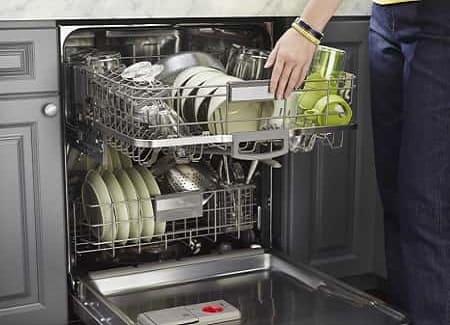
Appliances with such dimensions are perfectly combined with a standard kitchen set and are intended for families of 4-6 people. If you need to choose a smaller dishwasher, then it should be borne in mind that it holds no more than 9 sets of dishes and is 15 cm less deep.This is ideal for a family of 3. Miniature models have shown themselves on the good side, since the performance is high, and the cost is much lower. For 1-2 people, miniature appliances for 4 sets should be considered. They are 45x55x45 cm in size and can be easily placed on a table, on any other surface or hidden in a closet. Choosing a 45 cm dishwasher it is worth considering that it is suitable for a maximum of 2 users who are not too demanding on the quality of washing dishes. It can be a bachelor or too busy person. A standard machine works better because the water is supplied not in one direction, but in several. These types of dishwashers can be either built-in or freestanding. The first option is selected for the interior and kitchen design.
See also:
- 5 best Electrolux dishwashers
- 5 best Siemens dishwashers according to customer reviews
- 6 best Korting dishwashers according to customer reviews
- 6 best dishwashers VEKO of the year
- The 6 Best Midea Dishwashers
- 8 best Hotpoint-Ariston dishwashers
- The 8 Best Bosch Dishwashers
Leakage protection and drying
Almost all new dishwashers have a system that immediately stops the flow of water when leaking. It is worth noting that the more modern the protective system, the more expensive its cost. The higher the cost of the product, the less the risk of leakage and flooding in the apartment.
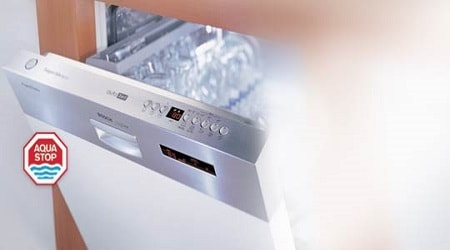
Not all models have the same type of drying. But the most economical and efficient is the built-in dryer, where the fan blows a clean set of dishes.
Electricity consumption, washing class, noise level
Before choosing a dishwasher for the home, it is also very important to pay attention to the washing class, energy consumption and noise level. Almost all dishwashers are class A, as this is the highest quality indicator. Many are interested in how much water it will consume during operation. Washing the dishes in the device reduces the amount of water used by half by hand washing. Basically, a set of 14 sets uses about 20 liters.
With a small flow of water, more electricity is required and in order for the dishwasher to work without failures, it is necessary to take into account the mains voltage. The device spends about 1–2 kW per cycle, but these figures depend on the load and the selected mode.
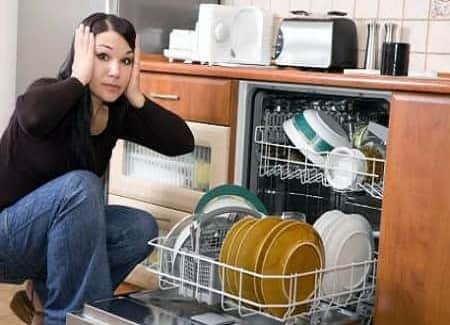
It is recommended to purchase the most silent model, modern cars are endowed with this quality. Older kitchen appliances are quite noisy, with noise levels reaching 55 decibels. But even an expensive option can have an increased noise level if you do not follow the rules for loading dish sets.
Dishwasher operating modes
Each model is equipped with its own set of modes that help save time and clean up any dirt. Here are some of the most popular ones.
- Half loading allows you to save water, electricity and a special detergent.
- Fast mode is recommended for use with a minimal degree of contamination of glasses, cups and plates.
- Intensive washing is ideal for heavily soiled dishes.
- Pre-soaking promotes better cleaning of kitchen utensils such as baking trays, pots and pans.
- The delicate mode is used for fragile crystal or glass objects.
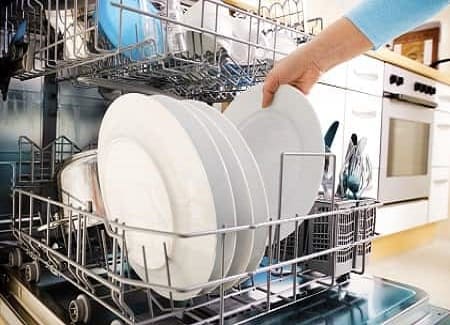
Water connection
In total, there are two types of connecting dishwashers to a water pipe. The first option consumes more electricity, since the equipment is connected only to cold water and the device heats it on its own. Other models are immediately connected to a hot water pipe, which reduces energy waste, but brings some inconvenience to the user. If the temperature regime does not correspond to the required level, the unit will simply turn off. Those who are not able to regulate the temperature of the supplied hot water should not buy a machine with this type of connection. If you choose a really high-quality model, then you need to choose equipment that is connected to both hot and cold water supply. Regulators will control the temperature of the water, lowering too hot and heating insufficiently warm. But such a dishwasher will cost several times more than standard models.
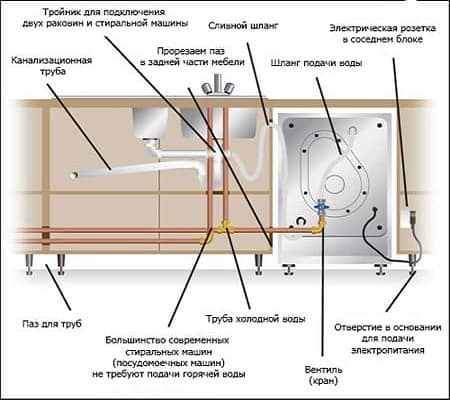
Control type
All dishwashers are divided into two types: electronic and mechanical. With the first type, programs are selected by pressing the buttons. Most often, such a device has a display that allows you to monitor the process. It provides information for the user, such as the name of the program, how much time is left until the end of the wash and the error number when it occurs. In another type of control, there is a switch on the mechanics, thanks to which the program is selected. During operation, the regulator turns, helping to monitor the sink.
![]() See also - Why the dishwasher does not turn on: causes of the malfunction
See also - Why the dishwasher does not turn on: causes of the malfunction
Economy and safety of equipment
Dishwasher manufacturers pay particular attention to the safety of their goods. The main thing is that there are no leaks and this can be checked by two methods. The first is a high-quality hermetic chamber for washing dishes, and the second is a reliable internal water supply. Many models are equipped with additional leakage protection. This will stop the water supply to the device if the machine is full or leaking. In more expensive kitchen appliances, a sound signal is installed to notify the user of a problem.
Equally important is the protection against electric shock. When the machine opens during washing, the unit is completely de-energized. Before buying, you should pay attention to child protection, which does not allow the smallest family members to open the door.
Tip:
Read also: Top 10 best dishwashers: reviews and market analysis
How much is a dishwasher
All models of kitchen appliances designed for automatic dishwashing are made by foreign manufacturers. Not big models of unpopular companies will cost about $ 300. For a machine with a camera occupancy of 8 sets of dishes, you will have to pay from $ 400. If the price does not matter to the user, then it is better to purchase a high-quality device of the highest class, which cost from 500 to 850 dollars. The main advantage of the machine is the economy in water consumption, high-quality washing and drying.
The cost of kitchen appliances also depends on functionality, the number of programs and dimensions. Cost built-in dishwashers higher than the standard, which can be placed separately. Manufacturers equip the product with a variety of add-ons and different capacities, but if all the parts inside are made of stainless steel, then the price will be higher.
![]() See also - Choosing a built-in dishwasher - practical tips, tricks
See also - Choosing a built-in dishwasher - practical tips, tricks
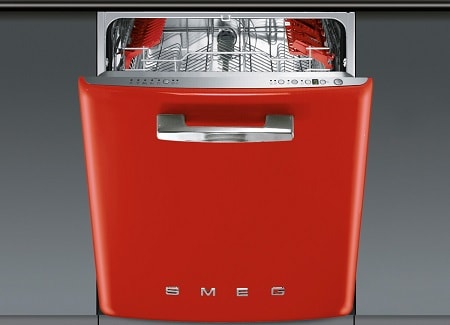
Choosing a dishwasher is not an easy task, because with a variety of models and functions, the buyer begins to get lost. But thanks to new technologies, you can find reviews of people on the Internet who already use the machine they like. The popularity and sales rating of a kitchen appliance for washing dishes will allow you to quickly determine which equipment is of high quality. Sometimes relatives and friends come to the rescue, who can advise a particular dishwasher, indicating all the advantages and disadvantages. Sometimes it is better to wait with a purchase and get a really worthwhile product than to buy a cheap option, but less quality. Only in this way household appliances in the kitchen will last a really long time, and the buyer will forget about the mountain of unwashed dishes, and will enjoy the new acquisition for a long time.
See also:

